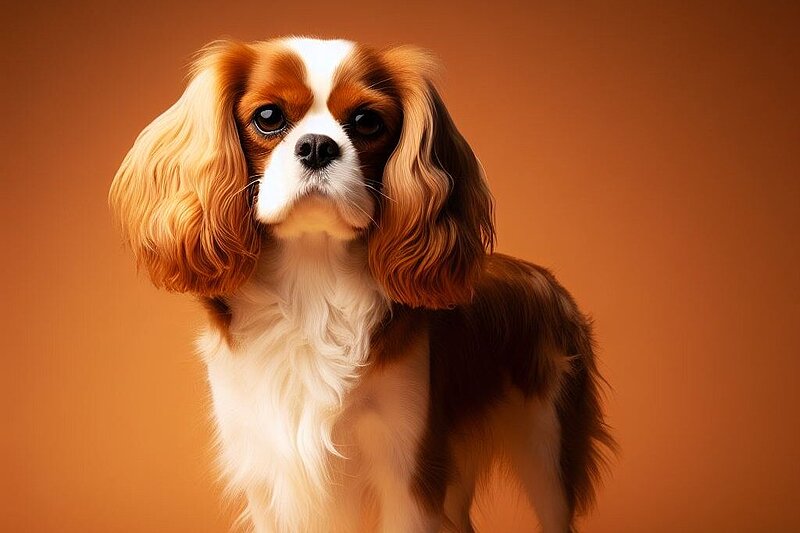The Cavalier King Charles Spaniel: Charming companion on four paws
The royal history of the Cavalier King Charles Spaniel
The history of the Cavalier King Charles Spaniel dates back to the 17th century, when the breed was extremely popular at European courts. The name "Cavalier King Charles Spaniel" comes from King Charles II of England, who was a great lover of these small dogs. The breed was so closely associated with the king that it is said that the dogs had access everywhere in the palace - even in the royal bedchambers!
Over the centuries, the breed underwent several changes. Originally known as the Toy Spaniel, it was later split into two different types: the modern Cavalier King Charles Spaniel and the English Toy Spaniel, also known as the King Charles Spaniel. The Cavalier King Charles Spaniel as we know it today was specifically bred to recreate the original appearance of the dogs from the time of King Charles II.
Who is the Cavalier King Charles Spaniel suitable for?
The Cavalier King Charles Spaniel is an extremely adaptable dog that is suitable for both families and individuals. It is known for its friendly and gentle nature and gets along well with children and other pets. Its small size and moderate activity level also make it ideal for city living.
Character and temperament
Cavalier King Charles Spaniels are known for their cheerful, loving and affectionate nature. They are very people-oriented and love to spend time with their owners. These dogs are extremely social and enjoy the company of other dogs and people. Their friendly and playful nature makes them great companions for families with children.
Appearance and physical characteristics
The Cavalier King Charles Spaniel is a small, elegant dog with a harmonious build. It has large, dark eyes, which give it a gentle expression, and long, silky ears, which are typical of the breed. The coat is of medium length, soft and wavy, and it comes in four different colors: Blenheim (chestnut and white), Tricolor (black, white and tan), Ruby (solid chestnut) and Black and Tan (black with tan markings).
Grooming and health
Grooming a Cavalier King Charles Spaniel requires regular brushing to keep its beautiful coat free of tangles and knots. Weekly grooming is usually sufficient. The ears should also be checked and cleaned regularly to prevent infections. It is also important to regularly check and care for the dog's eyes and teeth.
The breed is generally healthy, but as with many purebred dogs, there are some genetic conditions to look out for. These include mitral valve disease (heart problems), syringomyelia (a neurological condition) and hip dysplasia. A responsible breeder will carry out health checks to minimize the risk of these conditions.
Size and weight
An adult Cavalier King Charles Spaniel reaches a shoulder height of around 30 to 33 centimeters and weighs between 5.4 and 8 kilograms. This compact size makes it an ideal companion for both city life and rural environments.
Exercise requirements and habitat
Although the Cavalier King Charles Spaniel does not have extremely high energy levels, it still needs regular exercise to stay fit and healthy. Daily walks and playtime are important to satisfy their need for exercise. Thanks to its adaptable nature, it is suitable for life in the city as well as in the countryside.
Training recommendations
These dogs are intelligent and eager to learn, which usually makes training easy. Positive reinforcement and rewards lead to the best results with this breed. It is important to start socialization and training early to ensure a well-mannered and confident dog.
Behavior and interactions
Cavalier King Charles Spaniels are very social and get along well with other dogs and pets. They are patient and affectionate with children, making them great family dogs. Their gentle nature and friendliness also make them excellent therapy dogs.
Recognition by the FCI
Yes, the Cavalier King Charles Spaniel is recognized by the Fédération Cynologique Internationale (FCI) and belongs to Group 9 (Companion Dogs), Section 7 (English Companion Spaniels).
Interesting facts and conclusion
Did you know that the Cavalier King Charles Spaniel was once known as the "lap dog of kings"? Its charming nature and graceful appearance still make it a popular companion today. This breed is ideal for anyone looking for a loving, loyal and adaptable dog that feels at home both in the city and in the countryside.
